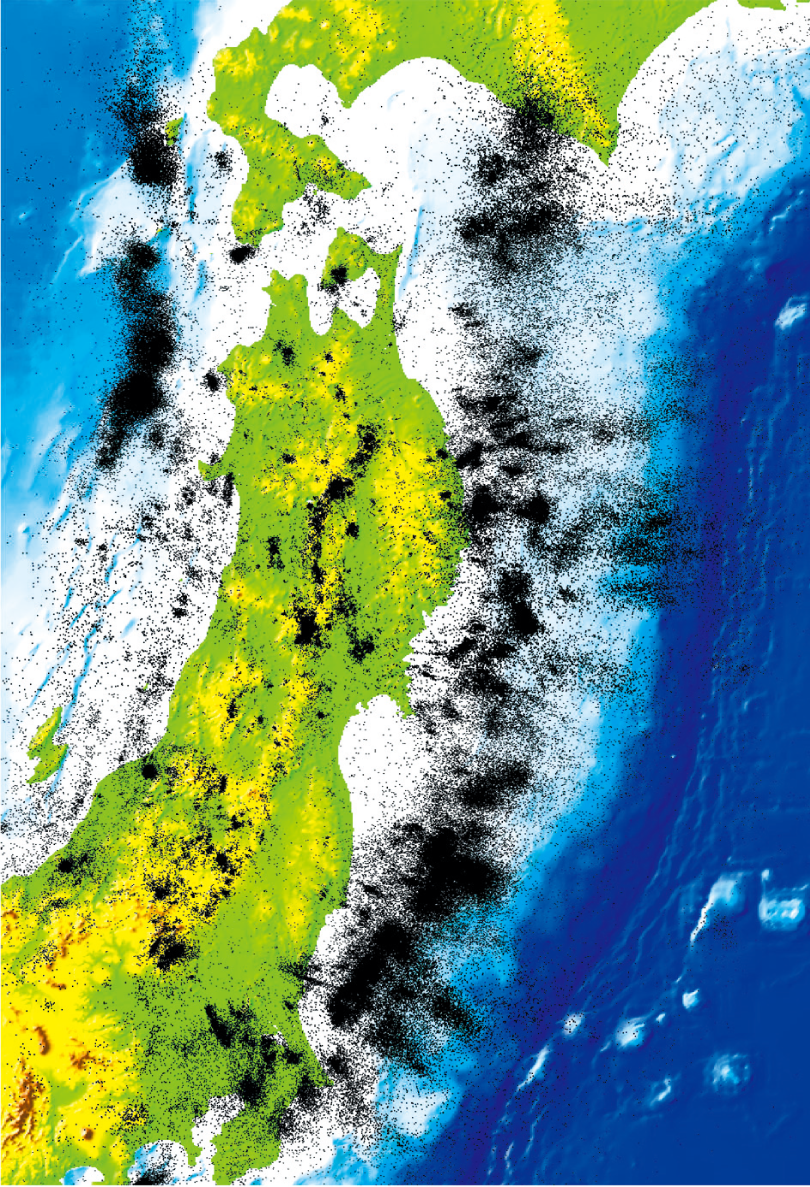Earthquakes and volcanic eruptions are one of the surface manifestations of the activities within the earth. “Plate subduction zone”, corresponding to the downward flow portion of the mantle convection system, plays important roles in the material circulation within the earth. Northeastern Japan is located in the typical plate subduction zone, where the Eurasian plate is subducting from the west side and the Pacific plate is subducting from the Japan Trench, which is on the east side. Therefore, seismic activities and volcanic activities are intensely active in NE Japan; it has frequently suffered from natural disasters such as repeating large earthquakes and volcanic eruptions over the years. In the meantime, NE Japan offers globally invaluable research resources for the deeper understanding of the dynamics of the plate subduction.
Our research center has been promoting the fundamental research in prediction of earthquakes and volcanic eruptions, focusing particularly on NE Japan which has such distinctive geological backgrounds. In order to improve prediction of earthquakes and volcanic eruptions, we believe that it is essential to have a deeper understanding of the plate subduction process causing earthquakes and volcanic eruptions along the island arc and of the resulting earthquakes and volcanic eruptions themselves. Therefore, even though our research is observation-based, we have been also incorporating methods of experimental and theoretical research to promote comprehensive study. Consequently, by producing multitude of study results, we’ve made an important contribution for a better understanding of the plate subduction process. Through understanding of the plate subduction process, we also have made considerable achievements that contribute importantly to the research of prediction of earthquakes and volcanic eruptions. For example, we have established a model of generation process of plate-boundary earthquakes and of inland earthquakes and elucidated the deep structure of island arc volcano.
We have effectively conducted our research by utilizing our geographical condition, as we are located in NE Japan which offers globally invaluable research resources. With the further development of our research, we aim at making further contribution to the advancement of research of prediction of earthquakes and volcanic eruptions. As spatially and temporally fluctuated plate motion has control over fluctuation of the stress field which is the cause of inland earthquakes, it is essential for prediction of occurrence of inland earthquakes as well as plate-boundary earthquakes to understand spatiotemporal fluctuation of plate motion. Based on observational data covering the whole area including both land and sea areas in the subduction zone, we are trying to gain a deeper understanding of tectonics of earthquakes and volcanoes in plate subduction zone and of plate subduction dynamics. Moreover, based on the elucidation of the nature and behavior of the fluids such as H2O and magma within the earth, in addition to contributing to the establishment of the eruption model and the quantification of prediction of eruption, we are trying to identify the effect that the fluids have on whole tectonic activities including seismic activities. By integrating all of these approaches, we are seeking to establish the prediction model of whole tectonic activities in subduction zones that will contribute actively to the improvement of prediction of earthquakes and volcanic eruptions.
Also, it is essential for a deeper understanding of plate subduction process to advance our research on the basis of a global perspective, including research on other subduction zones and hot spots where mantle material flows upward. In accordance with the idea mentioned above, we have been conducting international collaborative research with experts from all over the world, for example, on Pacific-rim plate subduction zone in Alaska and South America, and on hotspot volcanoes along the great rift valley in Democratic Republic of the Congo (former Republic of Zaire).We hope that our further development of such international collaborative research will contribute to research on tectonics of earthquakes and volcanoes in plate subduction zone and on plate subduction dynamics. We aim to become one of the centers of comprehensive study on plate subduction zone.

The epicenter distribution of shallow microearthquakes that occurred between 1975 and 1998. Topographical data were obtained from the Geographical Survey Institute and the Japan Coast Guard Hydrographic Department.
